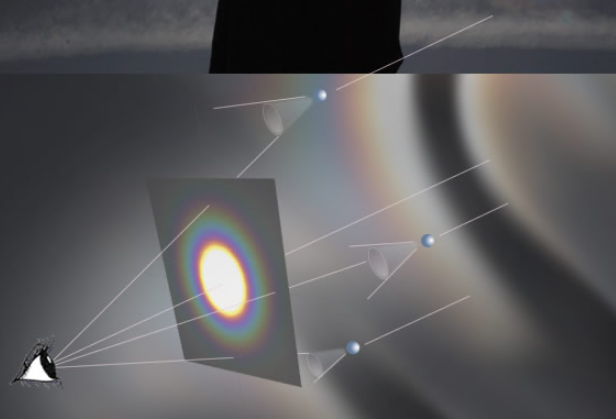Sunward Diffraction Pattern
Sunward Diffraction Pattern: Exploring the Phenomenon in Detail
When we gaze at the sky, we often encounter fascinating optical phenomena that captivate our attention. One such phenomenon is the sunward diffraction pattern, which occurs due to the interaction of sunlight with droplets in clouds and mist. In a previous OpticsPOD, we explored the brightest parts of this diffraction pattern, such as the fogbow and glory, which are observed opposite the sun. However, there is much more to uncover about this intriguing atmospheric phenomenon.
To understand the sunward diffraction pattern more comprehensively, it is important to delve into its characteristics and underlying mechanisms. The diffraction pattern consists of multiple rings known as a corona, which brighten as they approach the sun. For a symmetrical corona to form, droplets within the clouds need to be uniformly sized. However, when there is variation in droplet size across the clouds, the resulting corona exhibits distorted rings. In extreme cases, this can even lead to the formation of chaotic shapes known as cloud iridescence.
It is fascinating to note that each individual droplet contributes to the overall diffraction pattern by producing its own scattered radiation. The diagram representing this phenomenon depicts a diffuse cone of scattered radiation for each droplet. However, since we typically view droplets from a distance, they appear as mere specks of light to our eyes. These specks or glints correspond to fragments of the individual diffraction patterns that happen to be directed towards our eyes. As a result, when we observe a corona, what we are actually seeing is the collective effect of millions of individual diffraction glints.
The intricate nature of the sunward diffraction pattern lends itself to a visual spectacle that never fails to captivate us. To fully appreciate this phenomenon, it is essential to explore its variations and intricacies. For instance, a symmetrical corona with uniform droplet sizes produces well-defined and concentric rings. However, when droplets are irregularly shaped or vary in size, the resulting corona may exhibit irregularities and asymmetry. These irregularities can manifest as breaks or distortions in the rings, creating a visually stunning display.
The sunward diffraction pattern is not limited to just the corona. It is worth mentioning that other optical phenomena, such as the fogbow and glory, also contribute to the overall spectacle. The fogbow, which appears as a faint white or colorless arc opposite the sun, arises from the diffraction of sunlight by tiny water droplets in fog or mist. Similarly, the glory manifests as a series of concentric colored rings centered on the shadow of the observer's head. Both of these phenomena add to the complexity and beauty of the sunward diffraction pattern.
In conclusion, the sunward diffraction pattern is a captivating atmospheric phenomenon that arises from the interaction of sunlight with droplets in clouds and mist. While we may initially be drawn to its brightest components, such as the fogbow and glory, exploring the intricate details of the diffraction pattern unveils a mesmerizing display of rings known as a corona. Understanding the factors that influence the symmetry and shape of the corona, as well as its relationship with other optical phenomena, enhances our appreciation for this remarkable spectacle in the sky. Next time you find yourself gazing at the heavens, take a moment to observe and ponder upon the sunward diffraction pattern, a true marvel of nature's optics.

Intense Corona/Iridescence around the Duke of Argyll statue, Royal Mile, Edinburgh, Scotland. An unenhanced image August 25, '08 by Eva Seidenfaden (Paraselene Optics). Image ©Eva Seidenfaden, shown with permission.
Droplets in clouds and mist produce a single sky-wide diffraction pattern. The previous OpticsPOD showed its brightest parts opposite the sun, the fogbow and glory. Towards the sun the diffraction pattern brightens again in the multiple rings of a corona.
A symmetrical corona needs uniform sized droplets. When they vary in size across the clouds we see distorted rings (as here) and in more extreme cases the chaotic shapes of cloud iridescence.
Each individual droplet produces its own diffraction pattern represented in the diagram as a diffuse cone of scattered radiation. The eye does not see all the cone because - from a distance - the droplet is visible only as a speck of light. The speck or glint corresponds to the fragment of the individual diffraction pattern that happens to be directed towards the eye. The corona is the sum of millions of individual diffraction glints.

Note: this article has been automatically converted from the old site and may not appear as intended. You can find the original article here.
Reference Atmospheric Optics
If you use any of the definitions, information, or data presented on Atmospheric Optics, please copy the link or reference below to properly credit us as the reference source. Thank you!
-
<a href="https://atoptics.co.uk/blog/sunward-diffraction-pattern/">Sunward Diffraction Pattern</a>
-
"Sunward Diffraction Pattern". Atmospheric Optics. Accessed on November 26, 2024. https://atoptics.co.uk/blog/sunward-diffraction-pattern/.
-
"Sunward Diffraction Pattern". Atmospheric Optics, https://atoptics.co.uk/blog/sunward-diffraction-pattern/. Accessed 26 November, 2024
-
Sunward Diffraction Pattern. Atmospheric Optics. Retrieved from https://atoptics.co.uk/blog/sunward-diffraction-pattern/.